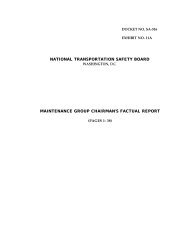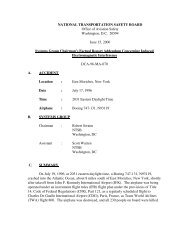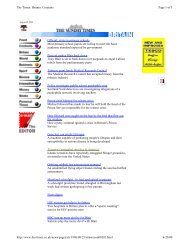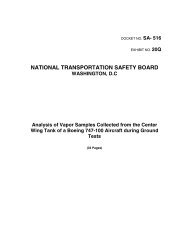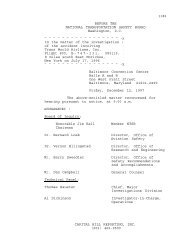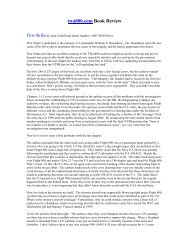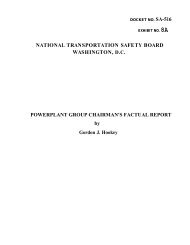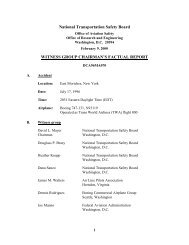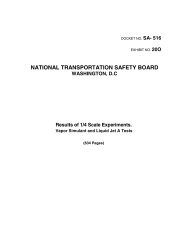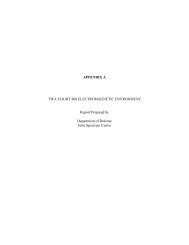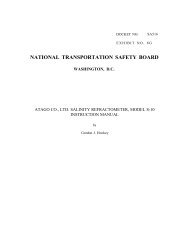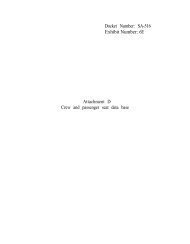Missile Self Destruct Performance Study - TWA Flight 800 Investigation
Missile Self Destruct Performance Study - TWA Flight 800 Investigation
Missile Self Destruct Performance Study - TWA Flight 800 Investigation
You also want an ePaper? Increase the reach of your titles
YUMPU automatically turns print PDFs into web optimized ePapers that Google loves.
Docket No.Exhibit No.SA-51622ENATIONAL TRANSPORTATION SAFETY BOARDWASHINGTON, D.C.MISSILE SELF DESTRUCT PERFORMANCE STUDY(23 page)
NATIONAL TRANSPORTATION SAFETY BOARDOffice of Research and EngineeringWashington, DCApril 13, 2000MISSILE SELF DESTRUCT PERFORMANCE STUDYBy Dennis CriderA. ACCIDENT: DCA-96-MA-070Location: East Moriches, New YorkDate: July 17, 1996Time: 2031 Eastern Daylight TimeAirplane: Boeing 747-131, N93119B. GROUP IDENTIFICATIONNo group was formed for this activity.C. SUMMARYOn July 17, 1996, at 2031 EDT, a Boeing 747-131, N93119, crashedinto the Atlantic Ocean, about 8 miles south of East Moriches, New York,after taking off from John F. Kennedy International Airport (JFK). Theairplane was being operated on an instrument flight rules (IFR) flight planunder the provisions of Title 14, Code of Federal Regulation (CFR), Part121, on a regularly scheduled flight to Charles De Gaulle InternationalAirport (CDG), Paris, France, as Trans World Airlines (<strong>TWA</strong>) <strong>Flight</strong> <strong>800</strong>.Explosion, fire, and impact forces with the ocean destroyed the airplane. All230 people aboard were killed.1
Figure 1; <strong>Missile</strong> fragmentation patternAs the warhead fragments move into the fragment pattern volume, the particlesrapidly disperse, reducing the number of fragments that would hit a given area asdistance from the explosion increases. According to the Defense IntelligenceAgency’s <strong>Missile</strong> and Space Intelligence Center (MSIC), about 1000 fragmentscan be expected from a warhead detonation. Dispersing 1000 fragments into thefragment pattern of figure 1, the number of warhead fragments into a 10 ft by 10ft spherical surface area can be calculated and is shown in figure 2. The numberof fragments that would impact a given area decreases with the square of thedistance of that area from the explosion.3
Number of Fragments/100 ft 21501401301201101009080706050403020100MANPADSWarhead Fragment Density0 5 10 15 20 25 30 35 40 45 50 55 60 65 70 75 80 85 90 95 100Radial Distance from Center (ft)Figure 2; fragment area densityAs an example, consider the missile encounter depicted in figure 3. Thefragment pattern from a self-destruction with this encounter covers over 634square feet of airplane surface area. About 140 square ft of this surface area isthe side of the fuselage under the wing. The fragment density at this location isabout 30 fragments per 100 square feet yielding a total of about 42 fragments.About 330 fragments (1/3 of the total) would impact the wing with the greatestfragment density directly above the missile.4
Figure 3; fragmentation pattern with warhead tracking perfectly in trail.MANPAD warhead detonation produces fragments in a range of sizes. Thedamage from these fragments can range from penetration to cratering and pittingto nothing (if the impact speed nears zero). Damage will be dependent on massof the individual fragments, the thickness and type of the material and thedistance between the material and detonation.According to MSIC the average MANPAD warhead fragment has a mass of lessthan 10 grains (0.0229 ounces). According to specialists at the Naval AirWarfare Center, Weapons Division at China Lake, warhead fragments can have5
a mass up to 40 grains. The Survivability/Vulnerability Information AnalysisCenter (SURVIAC) provided the Safety Board with data that showed that a 10grain fragment hitting the tank bottom perpendicularly requires a velocity of over3500 ft/sec to penetrate the bottom of the center wing tank. A 40 grain fragmenthitting the tank bottom perpendicularly requires a velocity of over 2000 ft/sec topenetrate the bottom of the center wing tank. Fragments hitting the tank at anangle require considerably greatervelocity to penetrate. For example,a 40 grain fragment hitting thebottom of the tank with a 60 degangle requires a velocity of over4500 ft/sec to penetrate the bottomof the tank. In addition SURVIACstated that test data show that, whena fragment must pass throughairplane skin before penetrating thecomponent of interest, it loses bothvelocity and mass. Thus highervelocities are required to penetratethe component of interest.MSIC provided the Safety Boardwith a test based speed decay ratefor MANPAD warhead fragments.MSIC also reported that warheadfragments could have an initialvelocity as high as 9000 ft/sec.Using the decay rate data provided and a 9000 ft/sec initial velocity, the velocitydecayed below 2000 ft/sec in less than 40 ft. Thus, a warhead must detonatewithin 40 ft of the tank for a warhead fragment hitting the tank perpendicularly tohave sufficient energy to penetrate the tank. Similarly, a 40 grain warheadfragment hitting the tank at a 60 degree angle must come from a detonation lessthan 17 ft away. Both these distances do not account for loss of fragment massor velocity through the fairing below the center wing tank.In order for a fragment to enter the center wing tank through the side wall, it mustenter and pass through the inboard wing tank. The inboard wing fuel tanksbordering the sides of center fuel tank were full with fuel. Since jet fuel isconsiderably denser than air, the speed of a fragment decays much more rapidlyin fuel than in air. Adjusting the test decay rate for fuel density shows that afragment traveling through Jet fuel will slow from 9000 ft/sec to 2000 ft/sec in lessthan one inch.6
ENCOUNTER GEOMETRYMany possible missile encounters end their flight approaching the airplane frombehind (such encounters will be discussed in later sections of this report). Figure3 shows the fragmentation pattern for a missile tracking an inboard engineperfectly in trail and exploding at the rear of the engine. Note that a missiletracking the outboard engines would be more than 40 ft from the tank. Warheadfragments for the inboard engine encounter would hit the bottom of the centertank at a very shallow angle (about 6 degrees) in comparison to theperpendicular hit required to penetrate the tank at 40 ft range. Therefore therange required for penetration with a missile tracking the inboard engine wouldbe less than the 17 ft required for penetration with a 60 degree hit. The centerline of the inboard engine is over 30 ft from the bottom of the center wing tank.Thus, fragments from missiles perfectly in trail of any engine would not be able topenetrate the tank. However, a missile explosion tracking the engines wouldresult in a large number of fragment holes in other areas of the aircraft structure.The “static” fragmentation pattern shown in the figure 3 approximates the actualpattern that is a function of both the velocity of the missile relative to the air massand the velocity of the fragments relative to the missileMISSILE PERFORMANCEThe performance of a missile guiding to an intercept of <strong>TWA</strong> <strong>800</strong> wasinvestigated using program MISSILE. MISSILE is a Windows based programdeveloped at the Safety Board that simulates a missile flight from a launchposition to an airplane on a given flight path. The program assumes that themissile follows it’s proportional guidance perfectly, that is there is no lag betweenthe guidance command and the response of the missile. The missile will followits guidance until its maximum maneuvering capability is reached. At this pointthe missile will turn in the commanded direction at the maximum rate possible.MISSILE uses aerodynamic, thrust, weight, geometry and destruct time dataobtained from the Naval Air Warfare Center, China Lake. China Lake alsoprovided sample flight time histories that were used to validate the program. Inan effort to bracket the possible missile performance range, China Lake provideddata for a low performance and a high performance missile. Due to the sensitivenature of the data, these missiles were not identified to the Safety Board. Thelow performance missile is referred to as SAM1 while the high performancemissile is referred to as SAM2.7
Program MISSILE requires as input a dataset containing the characteristics ofthe missile and a dataset containing the wind profile. The missile is launchedfrom coordinate 0,0 at a pitch lead angle and azimuth lead angle specified by theuser in a dialog box (figure 4). The position and velocity vector of the target atlaunch are specified by the user in a second dialog box (figure 5).Figure 4; example launch conditions dialogFigure 5; example target conditions dialog8
Weather conditions at sea level were 30.03 in Hg and 82.9 F. Winds used in thestudy are summarized in the following table. These winds were interpolated toeven altitudes from upper air data contained in the meteorological factual report(exhibit 5A).AltitudeWindDirection(deg)Wind Speed(kts)0 270 121000 270 122000 280 143000 285 174000 290 175000 303 196000 310 197000 315 17<strong>800</strong>0 320 169000 330 1210000 335 1211000 320 1212000 295 1613000 290 1614000 300 1715000 303 1916000 305 2117000 315 291<strong>800</strong>0 315 33At the time of simulated missile launch, <strong>TWA</strong><strong>800</strong> was climbing through 13700 ft ona heading of 71 deg at a ground speed of 363 kts and a flight path angle 2 of 2.1deg.A flight to a self destruction consists of approximately eight seconds of engineburn 3 followed by a high speed coast to a timed self destruction at 15 seconds(for SAM1 & SAM2; some missiles fly longer).Airplane position when the missile was launched was iterated to find the locus ofairplane positions at the time of launch that would result in an encounter at the 15second self-destruction time. To achieve a self destruction within 40 feet of the2 <strong>Flight</strong> Path Angle is the angle between the vertical and horizontal velocity components of theairplane.3 8.4seconds for SAM1, 7.8 seconds for SAM2.9
airplane, the initial airplane position had to be moved, on average, about 50 ftoutside the locus defined above (though it ranged to over 100 ft).A missile’s guidance in essence maintains the target at a constant closing anglerelative to the missile body. Better results are obtained by maintaining an angleto aim at a spot in front of the target. This angle is called a lead angle. Forexample, if a target airplane is approaching a MANPAD operator directly, theoperator could sight the target and then raise the missile’s launch angle tendegrees. This is a 10 degree pitch lead. Note that there is no need for anazimuth lead since the target is heading straight for the operator. However, if thetarget aircraft was passing abeam of the MANPAD operator, the operator couldsight the target and then rotate the missile launch angle ahead 10 degrees. Thisis a 10 degree azimuth lead. Note that there is no need for a pitch lead in thissituation. A 10 degree azimuth lead was used for these simulations whenappropriate.10
SAM1 <strong>Performance</strong>The airplane positions at missile launch that yield an encounter at the 15 secondself destruction time for the lower performance missile, known as SAM1, aregiven in figure 6.30000<strong>TWA</strong> <strong>800</strong>Sam1 <strong>Missile</strong> Encounter10 deg Pitch/Azimuth Lead Angle20000Aircraft Position at launch for encounter at 15 secLaunch SiteNorth (ft)100000-10000-20000DCABNote: Airplane positions inside thelocus of points typically would resultin an airframe to airframe encounterbefore the 15 sec self destructactivated. Airplane positions morethan 50 ft to 100 ft outside thislocus of points would result in amissile self destruction more than40 ft from the airplane.-30000-40000 -30000 -20000 -10000 0 10000 20000East (ft)Figure 6; SAM1 self destruction footprintWhen the airplane is at points A and B in figure 6 at the time of missile launch,the missile will approach the airplane from behind. Figures 7 and 8 show thefinal missile encounter for the case when the airplane is at point A at launch time.Figures 9 and 10 show the final missile encounter for the case when the airplaneis at point B at launch time. Moving along the locus curve to points C and D, themissile transitions to an approach from the side and below. Figures 11 and 12show the final missile encounter for the case when the airplane is at point C atlaunch time. Figures 13 and 14 show the final missile encounter for the casewhen the airplane is at point D at launch time. Note that the North view in the11
altitude plots may give a distorted impression of the climb angle for launcheswhen the airplane is at points C and D. The actual climb angles at the encounterare 57 and 56 degrees respectively. Note also that, for the figures, the missile isassumed to be targeting the airplane 4 to provide a good detonation location forgetting a missile fragment into the tank. Also note that the 747 graphic used inall altitude views in this report is a side view that has not been adjusted for the 71deg heading.Figure 7; Map view of encounter with target at point A at launch4 This report does not consider the probability of locking onto a hot element such as the engines or the airconditioningpacks in comparison to a cooler element such as a light or sun reflection.12
Figure 8; Altitude view of encounter with target at point A at launch13
Figure 9; Map view of encounter with target at point B at launch14
Figure 10; Altitude view of encounter with target at point B at launch15
Figure 11: Map view of encounter with target at point C at launch16
Figure 12: Altitude view of encounter with target at point C at launch17
Figure 13: Map view of encounter with target at point D at launch18
Figure 14: Altitude view of encounter with target at point D at launchFor the case when the airplane is at point A at launch time, the engine will burnout at 10126 ft. At this time the missile has a flight path angle of 52 deg, is on aheading of 31 deg, and is 4462 ft from the airplane.For the case when the airplane is at point B at launch time, the engine will burnout at 10377 ft. At this time the missile has a flight path angle of 52 deg, is on aheading of 110 deg, and is 4434 ft from the airplane.For the case when the airplane is at point C at launch time, the engine will burnout at 8570 ft. At this time the missile has a flight path angle of 45 deg, is on aheading of 220 deg, and is 9392 ft from the airplane.For the case when the airplane is at point D at launch time, the engine will burnout at 8437 ft. At this time the missile has a flight path angle of 44 deg, is on aheading of 285 deg, and is 9795 ft from the airplane.19
Referring to figure 3 as well as the encounter figures, it can be seen that thefragmentation pattern from missiles in chase (figures 7 to 10) will intersect thetank only when the missile detonates at very close range. As discussedpreviously, the wings are closer to the missile than the center tank area andwould be expected to get a high number (the example showed 240) of fragmentimpacts if the missile was targeted at an inboard engine. Fragmentation patternsfrom missiles approaching from the side and below (figures 11 to 14) couldintersect the center tank if the missile was targeting a thermal source on theopposite wing.20
SAM2 <strong>Performance</strong>The airplane positions at launch that yield an encounter at the 15 second selfdestruction time for the higher performance missile, known as SAM2, are given infigure 15.North (ft)3000020000100000-10000<strong>TWA</strong> <strong>800</strong>Sam2 <strong>Missile</strong> FootprintAircraft Position at Launch for encounter at 15 secLaunch SiteNote: Airplane positions inside thelocus of points typically would resultin an airframe to airframe encounterbefore the 15 sec self destructactivated. Airplane positions morethan 50 ft to 100 ft outside thislocus of points would result in amissile self destruction more than40 ft from the airplane.-20000-30000-40000 -30000 -20000 -10000 0 10000 20000East (ft)Figure 15; Footprint of target positions for various missiles encounter results for SAM2As can be seen, the higher performance significantly increases the size the selfdestructiontime footprint. The combination of greater range and slightly shorterengine burn time results in SAM2 being further away from <strong>TWA</strong> <strong>800</strong> at enginecutoff than SAM1. Using points at the same azimuths from the launch site asSAM1, the engine will burn out at 9264 ft for the case when the airplane is atpoint A at launch time. The distance to the airplane increases from 4462 ft to7608 ft. For the case when the airplane is at point B at launch time, the enginewill burn out at 8835 ft. The distance to the airplane increases from 4434 ft forSAM1 to 8205 ft for SAM2. For the case when the airplane is at point C at21
launch time, the engine will burn out at 8254 ft. The distance to the airplaneincreases from 9392 ft for SAM1 to 13335 ft for SAM2. For the case when theairplane is at point D at launch time, the engine will burn out at 8140 ft. Thedistance to the airplane increases from 9795 ft for SAM1 to 13270 ft for SAM2.22
CONCLUSIONSA missile engine would have shut down near the midpoint of the MANPADs flight.At this point the missile would be a considerable distance away from <strong>TWA</strong><strong>800</strong>.There is a large area around the missile launch point that an airplane must bewithin at missile launch for the missile to intercept the airplane before the missileself-destructs. However, a MANPADs self-destruction within 40ft of the airplanerequires the airplane to be in a very narrow band around this large area. Many, ifnot most, positions within this narrow band will not result in an encountergeometry that could send warhead fragments into the center wing tank.A warhead fragment heading to the sides of the tank would be rapidly slowedbelow tank penetration speed by the fuel in the inboard wing tanks. A fragmentheading into either the front or back of the tank would need to be from adetonation very close to the airplane skin to penetrate the tank. When thedetonation is close to the fore and aft location of the tank, short range is requiredbecause of the shallow fragment approach angle. When the detonation isdisplaced fore and aft from the tank, the required geometry places the detonationnear the skin of the airplane. In either case, a high density of fragments wouldbe expected on the airplane skin.A detonation directly below the center tank could allow a fragment to penetratethe tank while also resulting in the lowest fragment impact density to the airplane.At the maximum range for a 40 grain MANPAD warhead fragment to enter thetank from a detonation directly below (40ft), more than 20 fragments would beexpected to impact a 100 square foot (10 ft by 10 ft) area of the airplane. Fordetonations not directly below the tank, the fragment impact angle to the centerwing tank becomes shallow. This would require a detonation closer to the centerwing tank and because of the geometry, closer to other airplane structure. Thiswould produce a higher fragment impact density than noted above.As an example, figure 3 depicts a close-range detonation under the wing thatwould result in approximately 330 fragments impacting the underside of the wingand fuselage structure.Dennis CriderAerospace Engineer <strong>Performance</strong>23



